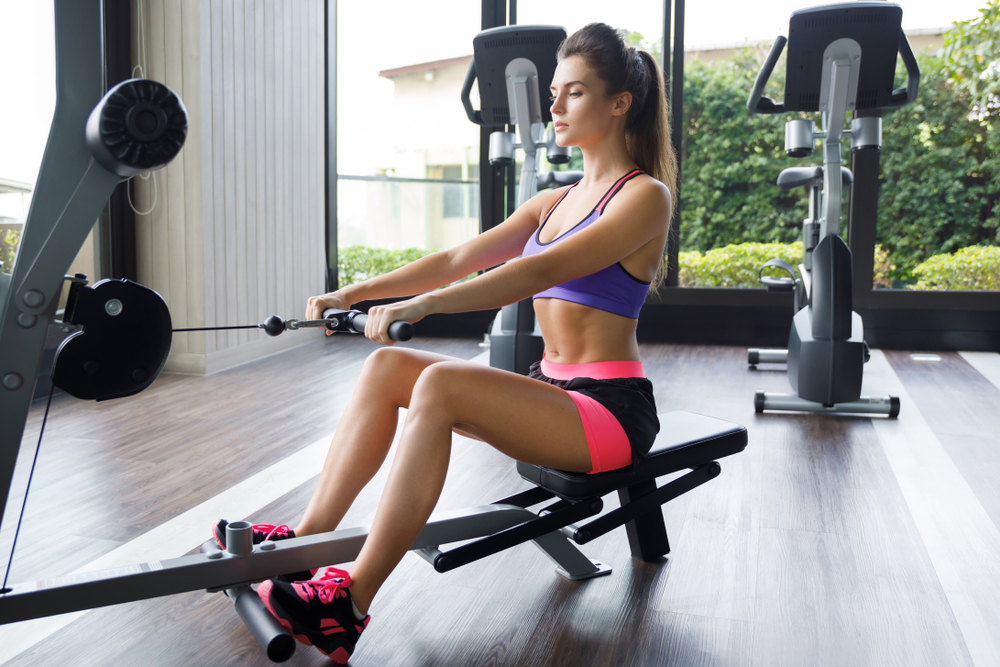The seated cable row is one of the best exercises for your back. Sometimes, however, you just can’t get in a set on the machine. Maybe you’re short on time and someone else is bogarting the machine. Perhaps you’re at home and you need a substitute that requires little or no equipment. No matter the reason, you’re in luck. There are plenty of alternatives that can give you as good a workout, if not better!
The top 10 seated cable row alternatives are underhand barbell row, pendlay row, bent over dumbbell row, single arm dumbbell row, chest-supported row machine, renegade row, seated resistance band row, landmine row, TRX suspension trainer row, and resistance band bent over row. These alternatives target the same muscles with the help of only dumbbells or a resistance band.
While some alternatives still require special equipment or machines, many do not. You can get a similar workout with just a set of dumbbells or a resistance band. Read on to find out more!
Contents
How Do You Do Seated Cable Rows Without a Machine?
In short– you don’t.
You need a specific machine to perform seated cable rows. However, there are a number of alternatives to target the same muscles without the need for the machine. Some require only dumbbells or a resistance band.
It’s undeniable that the seated cable row is one of the best exercises for your back. If it weren’t true, why else would so many people monopolize use of the machine every day? This can be problematic during peak hours or when you’re short on time.
To perform a seated cable row alternative without a machine, you will need a barbell, a set of dumbbells, or a resistance band to substitute. Using one of these pieces of equipment will allow you to row in similar fashion. This will also engage your muscles similarly, providing an equally effective workout.
How Do You Do a Seated Row at Home?
If it must be a true seated cable row, you’ll need to buy the machine. While they are expensive, they often come as part of bigger, more versatile machines. In this regard, investing in a multi-function machine that incorporates the seated row is a great investment. It does require a large space to dedicate for your home gym, as well as money to make the purchase.
A more accessible, more feasible option is to purchase a set of resistance bands. Resistance bands of varying resistance levels are lightweight and extremely versatile. Instead of cluttering up a whole room with a bulky machine, simply whip out your resistance bands and get to work.
With just a resistance band, you can perform seated rows or bent over rows. Both of these exercises activate your muscles similar to the seated cable row.
Plus, they’re lightweight, low profile, and relatively inexpensive. We can’t recommend resistance bands for your home gym enough!
What Muscles Do Seated Cable Rows Work?
The seated cable row works back muscles. The movement primarily targets your lats and rhomboids, with your traps and biceps performing some work as well.
Therefore, a suitable alternative must perform the same type of work. We looked for alternatives that also targeted the lats and rhomboids. Many alternatives roped in the trapezius and biceps as well. Some even expanded and recruited even more muscles to perform.
Standing alternatives require use of the legs and lower back to stabilize your posture throughout the movement. Compound movements like the renegade row hit the lats and arms hard while also torching your core, legs, and chest.
Even if you can get in a set on the seated cable row machine, alternatives are great too. Try incorporating some of our picks along with the cable row for maximum impact!
Is Seated Row the Same as Cable Row?
The seated cable row is a type of cable row. However, a cable row may also be performed standing. In this regard, the seated cable row is not exclusively a “cable row.”
The standing cable row has its merits as well. By standing, you must stabilize your posture and use your legs to hold firm. Many gym goers prefer the seated version for this reason. The machine and the bench allow you to really isolate your arms and back during the movement.
For this reason, we recommend the seated cable row over the standing alternative. The standing cable row is still useful, but often overshadowed by exercises like the bent over row or Pendlay row.
Cable Row Alternatives
While the seated cable row will work wonders for your back, it’s not always an option. Here are the best seated cable row alternatives you can do at the gym or at home.
1) Underhand Barbell Row
If you’re familiar with the bent over row, this exercise is extremely similar. Just sub out the pronated, overhand grip for a supinated, underhand grip and you’re in business. This alternative hits your back like the seated cable row, but also involves your lower back, glutes, and legs.
Here’s how to do the underhand barbell row with good form:
- Set up a barbell with the desired weight and stand before it, feet approximately shoulder-width apart. Squat to lift the barbell with an underhand grip.
- Bend at the hips to create a 30 to 45-degree angle with your chest angled to the floor. Bend softly at your knees while keeping your shins vertical.
- Pull the barbell upward toward the abs, bringing your elbows back.
- Slowly return to the starting position. Repeat as needed.
Remember to keep the movement strict and use your back and arms for the rowing motion. It’s tempting to use momentum to stack reps rapidly, but that’s only doing yourself a disservice. Keep your back flat and squeeze your back at the top of the movement.
2) Pendlay Row
Pendlay rows, named for the famous coach Glenn Pendlay, look similar to bent over rows. However, the weight comes to a dead stop between reps, activating your back muscles in a different way.
Here is how to properly perform the Pendlay row:
- Lean forward while holding a barbell until you can place it on the floor in front of you. A bumper plate or box may be used if you cannot reach the floor from a standing position.
- Pull the weight up from this position, rowing toward your hips. Keep your back flat, neck straight, and a very slight bend in your knees.
- Return the weight to the floor and release tension before the next rep.
- Repeat as needed.
You can sub a barbell for dumbbells if you feel so inclined. It’s a great sub to switch things up from the seated cable row or bent over rows. Plus, bringing the weight to a full stop between each rep builds explosive power. This will translate in a big way if you play competitive sports!
3) Bent Over Dumbbell Row
The bent over dumbbell row is an easy sub for seated cable rows. Instead of the cable machine, you’re using dumbbells and fighting gravity. Instead of sitting, you’re standing facing the floor. Despite these changes, you’re still getting the same great work done for your back, biceps, and triceps.
Here’s how to do the bent over dumbbell row:
- Grab a dumbbell in each hand and stand straight up. Your neck should be straight and your feet should be shoulder-width apart. Now hinge forward at your hips and create a 30 to 45-degree angle. Allow your arms to extend fully in front of you. Keep that back flat and your neck straight.
- Bend your knees slightly.
- Pull the dumbbells toward your core, bringing the elbows back. Squeeze your shoulder blades together at the top of the motion.
- Slowly return to the starting position. Repeat as needed.
Dumbbells bring an element of versatility to this tried-and-true back builder. If you keep the elbows locked tight, you’ll hit those lats hard. Now flare them out slightly, and you’re giving more attention to your upper back. Switch from a pronated grip to a neutral one and you’ll hit the triceps. Or are you feeling like Arnold and trying to target the biceps? Switch to a supinated grip and row away.
The possibilities are endless!
4) Single Arm Dumbbell Row
Another great thing about dumbbells is that you can isolate one arm at a time. This ensures you’re not getting by with one arm doing more work than the other. We recommend doing one side, then the other. However, you can use two dumbbells and do alternating single arm rows instead. The choice is yours.
Here’s how to do the single arm dumbbell row:
- Grab one dumbbell with a neutral grip and brace yourself with your off hand using a bench or chair. If electing to do alternating, grab two dumbbells. Hinge at your hips while maintaining a flat back and straight neck.
- For single arm rows, step forward with one leg to maintain a deep stance. For alternating rows, a slight bend in both knees is correct.
- Row the dumbbell up toward your body, bringing the elbow back. Squeeze at the top of the movement.
- Slowly return to the starting position. If alternating, repeat the steps for the other arm. If doing one arm at a time, repeat as needed and rest before repeating for your other side.
You get some great attention to your back, especially the lats, and your triceps in this movement. Doing this one arm at a time is great to ensure you’re getting full power in each rep. It will also help correct strength and size imbalances.
5) Chest-Supported Row Machine
Maybe you’re at the gym and you just can’t wait for someone to get off the cable row machine. If that’s the case, there’s a good chance there’s a chest-supported row machine only a few feet away. This machine is great because it is literally the same exercise, same angle, almost exactly the same. The only real difference is that the machine lets you push your chest into a pad for extra support. Also, the handles are more fixed compared to the cable machine, which allows more side-to-side movement during the motion.
Here’s how to use the chest-supported row machine correctly:
- Set the machine so that the handles come up to your mid-torso and that the handles require you to reach forward to grip.
- Set the desired weight.
- Keeping a flat back, take a deep breath in and exhale as you pull the handles toward your body. Your elbows should come back and down toward your torso.
- Inhale again as you return to the starting position slowly. Repeat as needed.
Of course, free weights provide a better workout in many ways. However, this machine is very useful at stabilizing the movement and really hitting the back and arms hard. Plus, you can implement drop sets more easily.
Try working a drop set of these at the end of your workout. It will be hard, but worth it!
6) Renegade Row
Ready for a real full body blaster? Renegade rows are one of the best exercises you can do in any circumstance. If you’re unfamiliar, imagine a push-up followed by a dumbbell row for each arm. Rinse, lather, repeat.
Here’s how to do renegade rows right:
- Grab two dumbbells and set them on the floor. Get into a push-up position, gripping one dumbbell with each hand. Check in with your form. Ensure your body forms a straight line from your head to your feet. Your arms should be close to the body. The weights and your hands should be directly beneath your shoulders.
- Perform a push-up. Keep your core tight and control the motion through the descent. Do not flare your elbows out to the sides. They should stay close to your body.
- After your push-up, row one dumbbell up to your torso. Squeeze your back at the top of the row. Slowly return it to the floor, then row the other dumbbell.
- Repeat as needed.
What does this exercise hit? What doesn’t this exercise hit? The push-up movement will hit your chest and arms while your core and legs benefit from holding tension. Now row each dumbbell upwards and hit those lats and back as well.
You basically hit everything with the renegade rows. We highly recommend incorporating these on occasion.
7) Seated Resistance Band Row
The seated cable row is great, but it’s very unlikely you have a machine like that at home. However, the seated resistance band row is a great substitute. And all you need is a resistance band to get it done!
Here’s how to do the seated resistance band row:
- Grab a resistance band and sit on the floor with your feet out in front. Anchor your resistance band to something mid to low torso level in front of you. Make sure it is sturdy and secure! You may use your feet if there is nothing available, but make sure it is secure! It can and will rubber-band toward your face if it slides off your feet!
- Sit upright with a straight, tall neck and flat back.
- Keeping your elbows close to the body, pull the handles toward your torso.
- Slowly return to the starting position. Repeat as needed.
Unlike the cable machine, resistance bands become more challenging as they stretch. Therefore, this exercise becomes more challenging as you get closer to the motion’s end point. This activates your back in a different way, making it very useful to incorporate into your regimen.
8) Landmine Row
Does your gym happen to have a barbell that’s inexplicably anchored into the floor? There are reasons you’d want a barbell like that. One of them is for doing landmine rows.
Basically, a landmine row is a bent over row that alters the angle of your body slightly as well as the grip. The landmine row uses a two-hand grip, almost like holding a baseball bat, and you pull the weight to your chest.
Here’s how to do landmine rows properly:
- If your gym doesn’t already have the barbell set but has landmine posts, anchor your barbell in now and load plates.
- Stand over the barbell and grab it with two hands. You should be closer to the top of the barbell so the weight comes up toward your upper chest at the end of the movement.
- Row the barbell into your body keeping your elbows tucked. Squeeze your back at the top of the movement.
- Slowly return to the starting position. Repeat as needed.
Sure, it’s a similar movement to many other rowing-type exercises. However, the unique stance and grip brings in additional muscles including the back extensors and legs. You won’t find it at every, but it’s a real treat if you are able to get in a set of these!
9) TRX Suspension Trainer Reverse Row
Another exercise which requires specialty equipment is the TRX suspension trainer reverse row. If you happen to have TRX at your gym, then you’re in for a real treat with this one. Using the straps and handles, all you need is to grab ahold and row your body up off the floor. In the process, you hit the lats, traps, rhomboids, and arms. Your core gets some benefit from holding tension as well.
Here’s how to do the TRX suspension trainer reverse row:
- Attach TRX at the appropriate location and adjust the length depending on your desired level of challenge. The more vertical you are, the easier the movement.
- Grab the handles while keeping your feet on the floor.
- Pull yourself toward the handles. Keep your hips extended and back flat throughout the whole movement.
- Slowly return to the starting position. Repeat as needed.
Be mindful of your form from start to finish on this one. You want to avoid losing tension in the core or legs. Don’t dip that butt. Keep everything tight and hold tension throughout the full movement to make sure you’re doing it right!
10) Resistance Band Bent Over Row
Remember when we subbed out our cable row for a resistance band equivalent? Ta-da! We’re doing it again with the bent over row!
This is an excellent substitute for if you have no weights available. It’s also great if you’re on the go or traveling or you don’t have any fitness center available. With just a single resistance band and your own two feet, you get a great workout for your arms and back.
Here’s how to do the resistance band bent over row:
- Hold the handles of a resistance band and step on the band with both feet. Your feet should be shoulder-width apart. Bend slightly at the knees, keep a flat back, and hinge at your hips. Your form should be identical to the bent over barbell row.
- Row the handles toward your body while keeping the elbows close to your body. Pinch your shoulder blades at the end of the movement.
- Slowly return to the starting position. Repeat as needed.
Remember– resistance bands are tricky. When they’re limp, they’re fairly easy to pull. However, the more tension you create, the harder the band fights back. You’ll feel the exercise most at the end of the movement. Make sure to squeeze to make each rep count!








